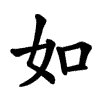Definify.com
Definition 2025
手
手
Translingual
| Stroke order | |||
|---|---|---|---|

| |||
Alternative forms
- 扌 (when used as a left Chinese radical)
Han character
手 (radical 64 手+0, 4 strokes, cangjie input 手 (Q), four-corner 20500)
- Kangxi radical #64, ⼿ (“hand”).
References
- KangXi: page 416, character 28
- Dai Kanwa Jiten: character 11768
- Dae Jaweon: page 762, character 9
- Hanyu Da Zidian: volume 3, page 1824, character 1
- Unihan data for U+624B
Chinese
|
simp. and trad. |
手 | |
|---|---|---|
Glyph origin
| Historical forms of the character 手
| ||||
|---|---|---|---|---|
| Oracle bone script | Bronze inscriptions | Bamboo and silk script | Large seal script | Small seal script |
 |
 |
 |
 |
 |
| Characters in the same phonetic series (手) (Zhengzhang, 2003) | |
|---|---|
| Old Chinese | |
| 杽 | *n̥ʰɯwʔ |
| 手 | *hnjɯwʔ |
Pictogram (象形) – hand and fingers. The top stroke is the bent over middle finger, while the horizontal strokes are each two fingers. Compare 爪, 寸, 九.
Note that unlike the other hand/claw characters, 手 has consistently had five fingers: a mammalian/human hand, as opposed to the three digits often found in the others.
Compare also 止 (“foot”), derived from a footprint, originally composed of 3 toes and a sole.
Pronunciation
- Mandarin
- Cantonese (Jyutping): sau2
- Hakka (Sixian, PFS): sú
- Min Dong (BUC): chiū
- Min Nan (POJ): chhiú / siú
- Wu (Wiktionary): seu (T2)
- Mandarin
- (Standard Chinese, Beijing)+
- Pinyin:
- Zhuyin: ㄕㄡˇ
- Wade-Giles: shou3
- Gwoyeu Romatzyh: shoou
- IPA (key): /ʂoʊ̯²¹⁴/
-

- (Standard Chinese, Beijing)+
- Cantonese
- (Standard Cantonese, Guangzhou)+
- Jyutping: sau2
- Yale: sáu
- Cantonese Pinyin: sau2
- IPA (key): /sɐu̯³⁵/
- (Standard Cantonese, Guangzhou)+
- Hakka
- (Sixian, incl. Miaoli and Meinong)
- Pha̍k-fa-sṳ: sú
- Hakka Romanization System: su`
- Hagfa Pinyim: su3
- IPA: /su³¹/
- (Sixian, incl. Miaoli and Meinong)
- Min Dong
- (Fuzhou)
- Bàng-uâ-cê: chiū
- IPA (key): /t͡sʰieu³³/
- (Fuzhou)
- Min Nan
- (Hokkien)
- Pe̍h-ōe-jī: chhiú / siú
- Tâi-lô: tshiú / siú
- Phofsit Daibuun: chiuo, siuo
- IPA (Xiamen): /t͡ɕʰiu⁵³/, /ɕiu⁵³/
- IPA (Quanzhou): /t͡ɕʰiu⁵⁵⁴/, /ɕiu⁵⁵⁴/
- IPA (Zhangzhou): /t͡ɕʰiu⁵³/, /ɕiu⁵³/
- IPA (Taipei): /t͡ɕʰiu⁵³/, /ɕiu⁵³/
- IPA (Kaohsiung): /t͡ɕʰiu⁴¹/, /ɕiu⁴¹/
-

- Note: chhiú - vernacular, siú - literary.
- (Hokkien)
- Wu
- (Shanghainese)
- Wiktionary: seu (T2)
- IPA (key): /sɜ³⁴/
- (Shanghainese)
| Rime | |
|---|---|
| Character | 手 |
| Reading # | 1/1 |
| Initial (聲) | 書 (26) |
| Final (韻) | 尤 (136) |
| Tone (調) | Rising (X) |
| Openness (開合) | Open |
| Division (等) | III |
| Fanqie | 書九切 |
| Reconstructions | |
| Zhengzhang Shangfang |
/ɕɨuX/ |
| Pan Wuyun |
/ɕiuX/ |
| Shao Rongfen |
/ɕiəuX/ |
| Edwin Pulleyblank |
/ɕuwX/ |
| Li Rong |
/ɕiuX/ |
| Wang Li |
/ɕĭəuX/ |
| Bernard Karlgren |
/ɕi̯ə̯uX/ |
| Expected Mandarin Reflex |
shǒu |
| Baxter-Sagart system 1.1 (2014) | |
|---|---|
| Character | 手 |
| Reading # | 1/1 |
| Modern Beijing (Pinyin) |
shǒu |
| Middle Chinese |
‹ syuwX › |
| Old Chinese |
/*n̥uʔ/ |
| English | hand |
Notes for Old Chinese notations in the Baxter-Sagart system: * Parentheses "()" indicate uncertain presence; | |
| Zhengzhang system (2003) | |
|---|---|
| Character | 手 |
| Reading # | 1/1 |
| No. | 11665 |
| Phonetic component |
手 |
| Rime group |
幽 |
| Rime subdivision |
2 |
| Corresponding MC rime |
首 |
| Old Chinese |
/*hnjɯwʔ/ |
Definitions
手
- hand
- expert; master
- 高手 ― gāoshǒu ― master
- -ist; -er
- 歌手 ― gēshǒu ― singer
- convenient; handy
- Classifier for transactions.
See also
Compounds
|
|
|